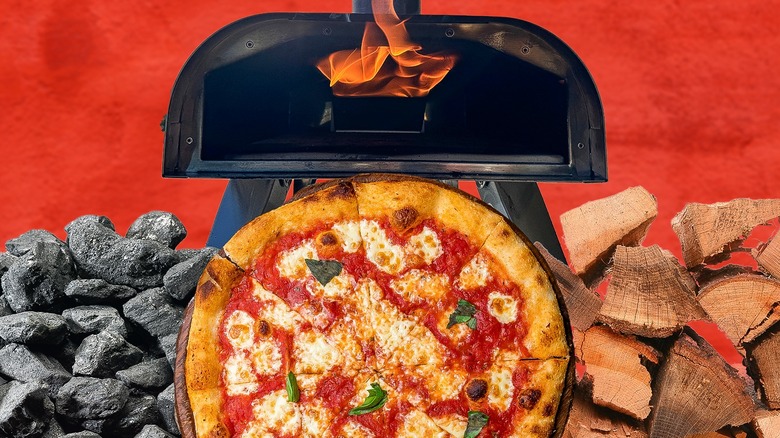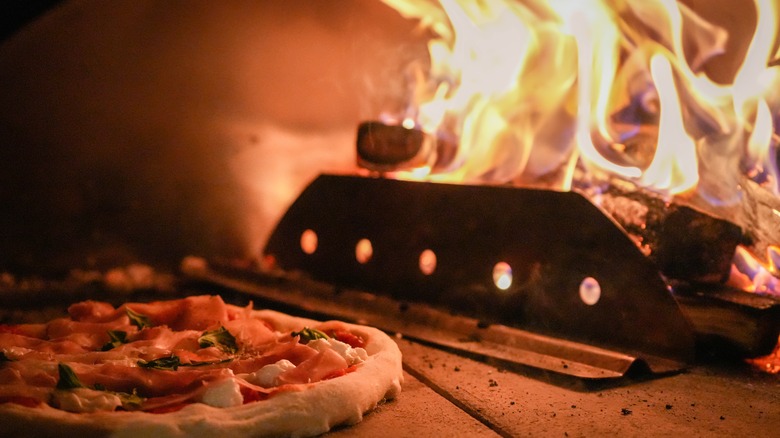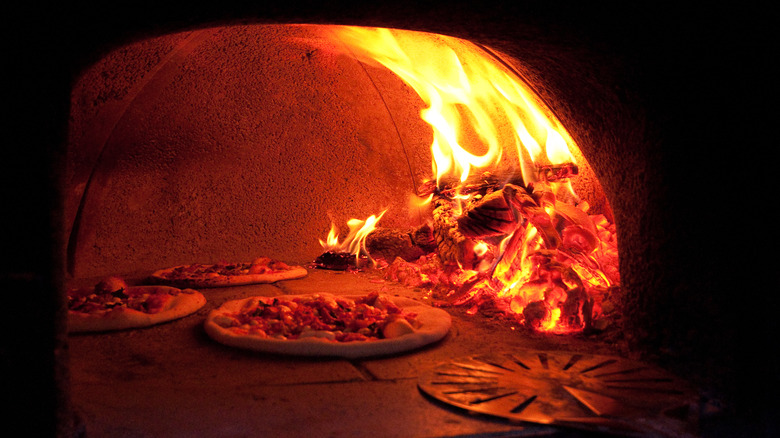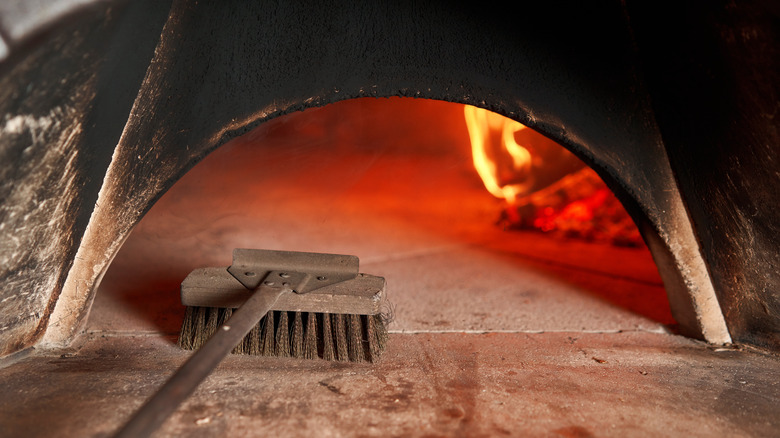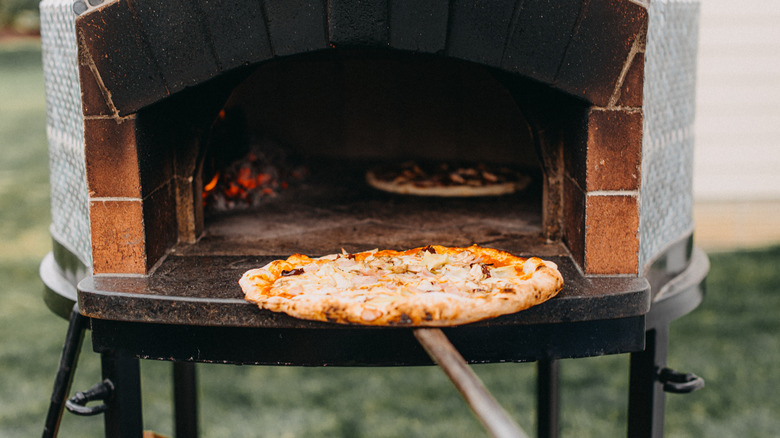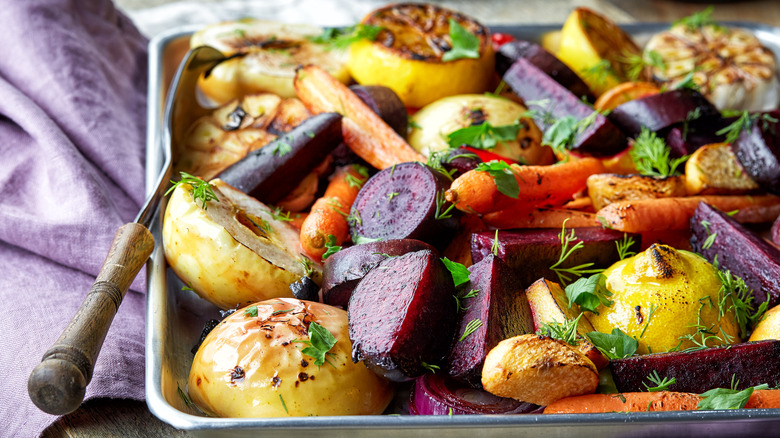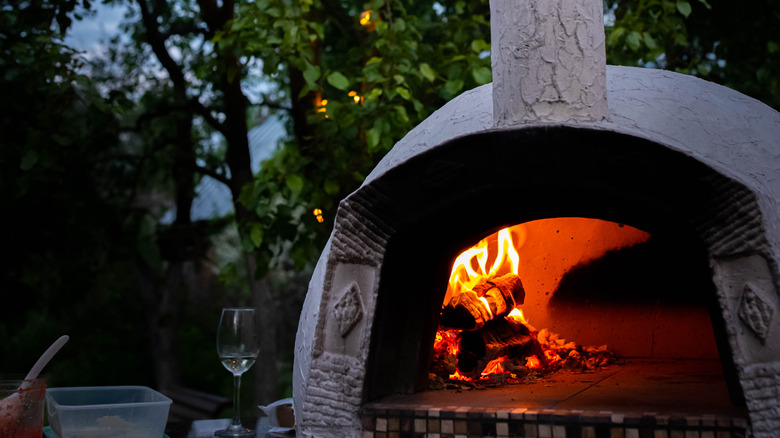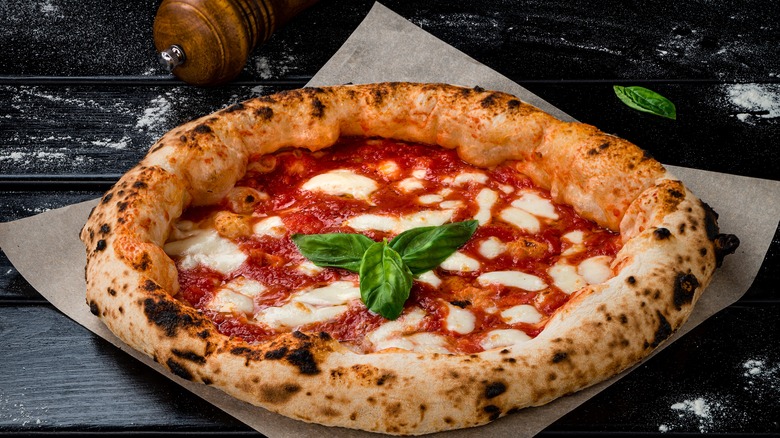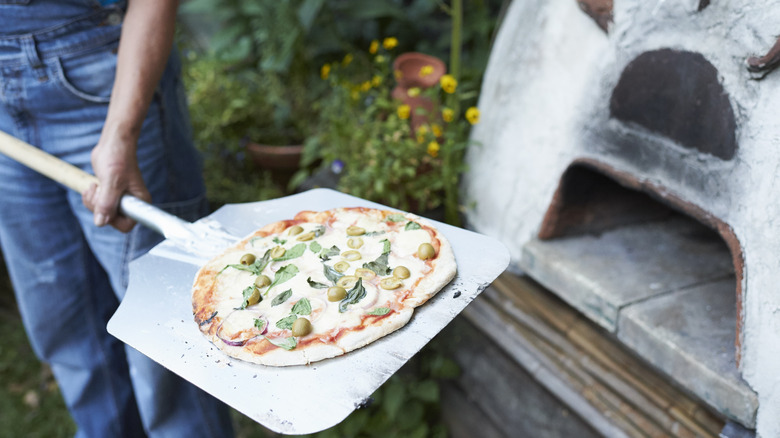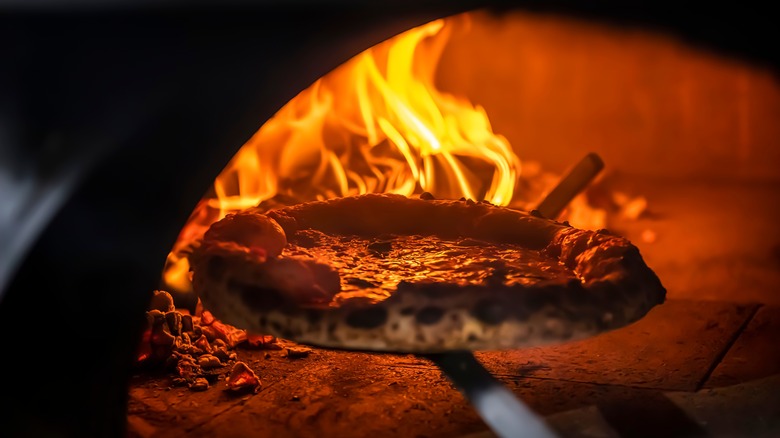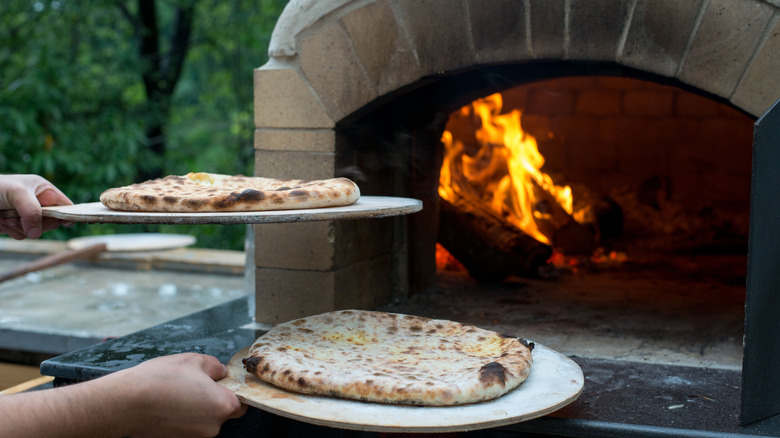Mistakes You're Probably Making With Your Pizza Oven
We may receive a commission on purchases made from links.
Pizza may be one of the most universally loved foods. Who can resist a perfectly crisp crust, rich tomato sauce, bubbly melted cheese and all your favorite toppings? As beloved as this dish, there is a lot of debate over what makes the perfect pizza and what type of pizza is the best. Learning to make pizza at home gives you the opportunity to create the ultimate pie that exactly matches your taste. Making your own means that you get your choice of thin or thick crust with classic or unexpected pizza toppings. You can get creative and create your own unique dish to impress yourself and your family.
While you can bake pizza in a standard kitchen oven, one of the best ways to take your homemade pizza to the next level is by using a pizza oven. A pizza oven is a specialized appliance that can be powered with gas, coal, or wood, depending on the variety. It's able to reach very high temperatures, which makes pizza crust extra crisp, flavorful and helps to avoid soggy pizza dough.
While pizza ovens are handy tools, there are common mistakes that make them less effective. If you're new to using a pizza oven or struggling to get your desired results, there are several reasons for this. After consulting with pizza chefs and experts, we've found the top 10 most common pizza oven mistakes and how you can best avoid them for incredible pizza!
Using the wrong kind of wood or coal
Some pizza ovens use wood, while others use charcoal. Either can be a great option, but the type of wood or coal you use is essential to pay attention to. When using a pizza oven, your fuel makes a huge difference in the recipe's texture and overall flavor. Some types of fuel don't burn as long or as hot and can result in an uneven cooking temperature. On top of that, some varieties release chemicals that can affect the taste of the pizza.
Sayed Seyar, the Co-Owner of Pizza Ponte, shared the best types of wood to avoid these problems. "When it comes to firing a pizza oven, the best choices are hardwoods like oak, hickory, or maple. These woods burn hot and produce a steady, even heat, which is essential for achieving that perfect pizza crust. They also impart a subtle flavor to the pizza, enhancing the overall taste." With that in mind, Seyar does also recommend experimenting with softwoods, such as pine. "They tend to burn quickly and can release resin, which can affect the flavor of your food."
When it comes to charcoal, Seyar recommended lump coal since it burns hotter and produces less ash and chemicals than briquettes. "Ultimately, the key is to choose a fuel that burns cleanly and efficiently, allowing you to reach and maintain high temperatures for optimal pizza baking," he said. However, just as common charcoal mistakes can ruin your barbecue, you'll need to keep in mind best practices for using charcoal in the pizza oven.
Using the wrong amount of fuel
Just as important as the type of fuel you use is the amount of wood or coal in your pizza oven. Too little fuel makes it hard for the oven to come to temperature, leading to longer and uneven cooking. But, adding too much can make the oven too hot and burn the pizza, as well as making too much smoke. Unfortunately, this is an easy mistake to make because the amount of fuel depends on several factors, such as oven size, pizza style, and cooking time.
As a general rule, Frank Kabatas, Owner and Operator of East Village Pizza, told Chowhound that 14 to 17 coals will bring the pizza oven temperature to around 300-325 degrees Fahrenheit, and 23-25 coals will raise it to between 500 and 550 degrees Fahrenheit. "The amount is crucial because using too much or too little coal can drastically affect how the pizza turns out," he said. "Additionally, if your oven has a bottom fire feature, which most coal ovens are equipped with, you should place around 8 coals at the bottom and distribute the rest on top as this helps properly cook the pizza." If the process of measuring fuel and building a fire seems overwhelming, Sayed Seyar recommended getting a gas-powered brick oven for more precise temperature control.
Not cleaning the oven properly
To keep your at-home pizza oven operating at full capacity, you need to clean it consistently. Sayed Seyar explained that leaving ash, grease, and food residue in your oven will affect your pizza's taste. If you let it build up too long, it can impact airflow and heating in the oven. "Regular cleaning reduces the risk of flare-ups caused by grease or leftover food, making your cooking experience safer," Seyar said. It's recommended that you brush out ash and food debris after every use and doing a deep clean every week or so, depending on how often you use the oven. Eidref Laxa, Ooni Ambassador and pizza podcaster of "What's Good Dough?", said he cleans his pizza oven after every five uses to avoid ash buildup and other problems.
When it's time to give your oven a deep clean, Frank Kabatas shared the oven cleaning method used at East Village Pizza. He recommends cleaning the outside with warm water and a mild degreaser. Then, gently scrub the inside with warm water and a sturdy brush. Then, leave the oven on the heat for an hour without cooking to help cook off any stuck-on foodstuff. He then recommends making a natural cleaner with baking soda and lemon to scrub down the inside of the oven. "It's important to never use chemicals inside the oven," he explained. Rinse out the cleaner with warm water and wipe it all down with a microfiber cloth to finish.
Putting your oven in the wrong place
There are lots of common kitchen mistakes that affect food safety. When it comes to pizza ovens, one of the biggest safety issues is where you place the oven. When setting up an at-home pizza oven, you need to consider airflow and other factors for easy and hazard-free cooking. Frank Kabatas recommended considering both safety and convenience when finding the spot for your oven. "If you're placing your pizza oven indoors, make sure that it is located near a well-functioning chimney to properly ventilate the smoke and heat, especially for wood or coal-fired ovens," he said.
Some other factors, which Sayed Seyar pointed out are ensuring you pick a flat surface, so that the pizza oven isn't at risk of tipping, or shifting whil in use. And checking the oven is a safe distance from flammable material like wood, and cloth.
If you're placing the pizza oven outside there are other environmental factors to consider. Placing your pizza oven near dense vegetation can easily lead to fires. You should also pick a location shielded from strong winds. Seyar explained that having a pizza oven in a windy location can affect the temperature and in some cases lead to the flames spreading, causing dangerous accidents.
Only using your pizza oven for pizza
While the name "pizza oven" makes this appliance sound like a one-trick pony, in reality, you can make so many different kinds of dishes in it. Limiting the oven to just cooking pizza is a huge mistake. The high heat allows it to make crisp, flavorful dishes with a variety of different types of food. If you're already using your pizza oven to make pizza, you might as well use it to roast vegetables, bread, and other flavorful sides to make the most out of the fire.
"Pizza ovens are versatile cooking appliances that are suitable for so much more than pizza. At Pizza Ponte, we cook our homemade garlic bread and calzones in our pizza ovens," Sayed Seyar said. "You could also cook meat and fish, roast vegetables, or melt quesadillas. Basically, anything that can be made in a conventional oven can also be made in a pizza oven."
Eidref Laxa also shared that he loves using his pizza oven for lots of recipes. "I make steak, taco meat, bread, roast chicken and so much more! Baked mac and cheese is probably my favorite so far," he said. Be sure to take full advantage of your pizza oven and use it for meat, seafood, veggies, potatoes, crispy bread, corn on the cob, and more! Try our cheesy roasted tomato pie for another recipe that would taste amazing baked in the pizza oven.
Not creating proper air flow
One of the most important things to consider when setting up the fire in your pizza oven is airflow. It's essential to create a well-ventilated space where air can easily escape and enter the oven. If air gets trapped in the oven, you'll have smoke and ash build-up, which can choke out the flame and affect the flavor of the pizza. Plus, the flame needs oxygen to grow and come to temperature. "Airflow is essential for fire, especially wood-fired cooking," Eidref Laxa told Chowhound. Overloading the oven can also negatively impact airflow. "Placing too much wood or charcoal will prevent you from raising your temperature," Laxa explained. "I learned this the hard way during my first wood-fired bake."
Some key factors to consider for proper ventilation is ensuring there is no overhead obstruction above the chimney. If you set up the oven indoors, the chimney will need to extend through the roof, and if it's outside, you'll still need to ensure it's not under a patio or any other covered top. Oven placement and the amount of fuel will also change the level of ventilation. You can also adjust air flow using the oven door and vents. This is another reason oven cleaning is so essential since the buildup in the vents and chimney can block proper ventilation.
Cooking before the pizza oven is up to temperature
Another easy mistake to make is putting your pizza in the oven before it reaches temperature. Pizza ovens, particularly wood or charcoal ovens, take time to heat up. Adding the pizza too early will result in slow, uneven cooking. To avoid this mistake, remember to start your oven early and let the wood burn for a couple of hours to bring the oven to temperature before adding the pizza. "Taking the time to cook pizza at the right temperature for the right amount of time ensures that it will be high-quality and achieve the ideal balance of crispness and flavor," Frank Kabatas said. The exact cooking temperature you want will vary based on the type of pizza you're making and the hydration of the dough.
Gregorio Fierro, Master Instructor for Scuola Italiana Pizzaioli, also cautioned that you'll run into more problems if you heat the oven too high. "The new generation of outdoor pizza ovens ... tend to get hotter than what most home cooks are used to. It is important to monitor the oven temperature, and it might be necessary to raise and lower the fuel source during your baking cycle in an effort to keep the oven from getting too hot," Fierro said.
To gauge the heat of your pizza oven, you can purchase a laser-guided infrared temperature gauge, which allows you to check the oven temperature from a safe distance. Then, you can adjust the amount of fuel as needed for the proper cooking temperature.
Using your pizza peel wrong
A common problem cooks run into is having the pizza dough stick to the pizza peel. Once the oven comes to temperature, you want to be able to slide your pie into the hot oven easily. But when it gets stuck to the peel, it's hard to transfer to the oven without losing toppings, flipping the pizza, or burning yourself. You'll find this issue coming up if you're using a hot or damp pizza peel. This is particularly easy to do if you're cooking more than one pie since the heat and condensation from the first pizza causes the dough to stick to the pizza peel.
To avoid this and easily launch your pizza into the oven, Tom Voyage recommended having more than one pizza peel. "That way, when you take a hot pizza out of the oven, and you get some condensation on the peel, you can use another peel to put your dough back in," he explained in a Youtube video.
Dusting the bottom of your pizza pie with some type of flour will help your prevent sticking on your pizza peel. Eidref Laxa said he's found semolina flour works best for this job. "I have experimented with them all — flour, rice flour, and cornmeal — but my favorite is semolina. A coarse-ground semolina gets your pizza super crunchy. The trick is to use enough to cover the dough, but do use a perforated peel to shake off the excess," he said.
Not turning the pizza during the cooking time
While it would be wonderful if you could just pop your pizza in the oven and leave it until it's done, that's not going to work very well with a pizza oven. Forgetting to turn your pizza is a big mistake. The way pizza ovens are set up, the heat source typically comes from one side, so leaving the pizza in one spot the entire cooking time will lead to uneven cooking as the side next to the flame heats much more quickly. "Be prepared to keep the pizzas moving in the oven. Most of them have very directional heat sources, and if you're not ... spinning the pizza, you'll have one burnt side and one raw side," Gregorio Fierro warned.
Exactly how often you should be turning the pizza will vary depending on how hot your oven is, how close the pizza is to the heat source, the size of the pie, and other factors. "In a perfect world, you only have to turn it 1-2 times, depending on the oven," Eidref Laxa said. However, due to the many variants, you may have to turn your pizza more often. "Because dough is a living thing, you typically need to be more involved with the bake to avoid burning," Laxa continued. Pay attention to how quickly your pizza is cooking and turn when necessary to even it out the baking process.
Not following regulations and safety precautions
While some of these mistakes will affect the quality of your cooking, the worst mistake you can make is ignoring safety protocols. Pizza ovens work well because they come to very high temperatures, but this also makes them dangerous appliances that you need to be careful with. Taking care of how and where you set up the pizza oven and fire safety is essential to ensuring nothing dangerous happens in your effort to make the perfect pizza.
Some of the tips already shared in this post, such as cleaning your pizza oven and ensuring proper ventilation, will help with safe use. A few other essential guidelines to remember are that you should never clean your pizza oven without giving it plenty of time to cool. This may seem obvious, but remember that the oven takes time to heat and cool, so attempting to clean it too soon can lead to burns. You should also monitor the oven temperature to ensure it doesn't get too hot, don't leave the hot oven unattended, and don't attempt to use your pizza oven to heat your home, as this is not what it's intended for.
Depending on where you live, there may be regulations and permits required to set up a pizza oven. Be sure to obtain all the proper clearances before installing it. If you're placing your pizza oven over a table, counter, or any other surface, Eidref Laxa pointed out you need to make sure the surface isn't flammable and won't melt at high temperatures.
